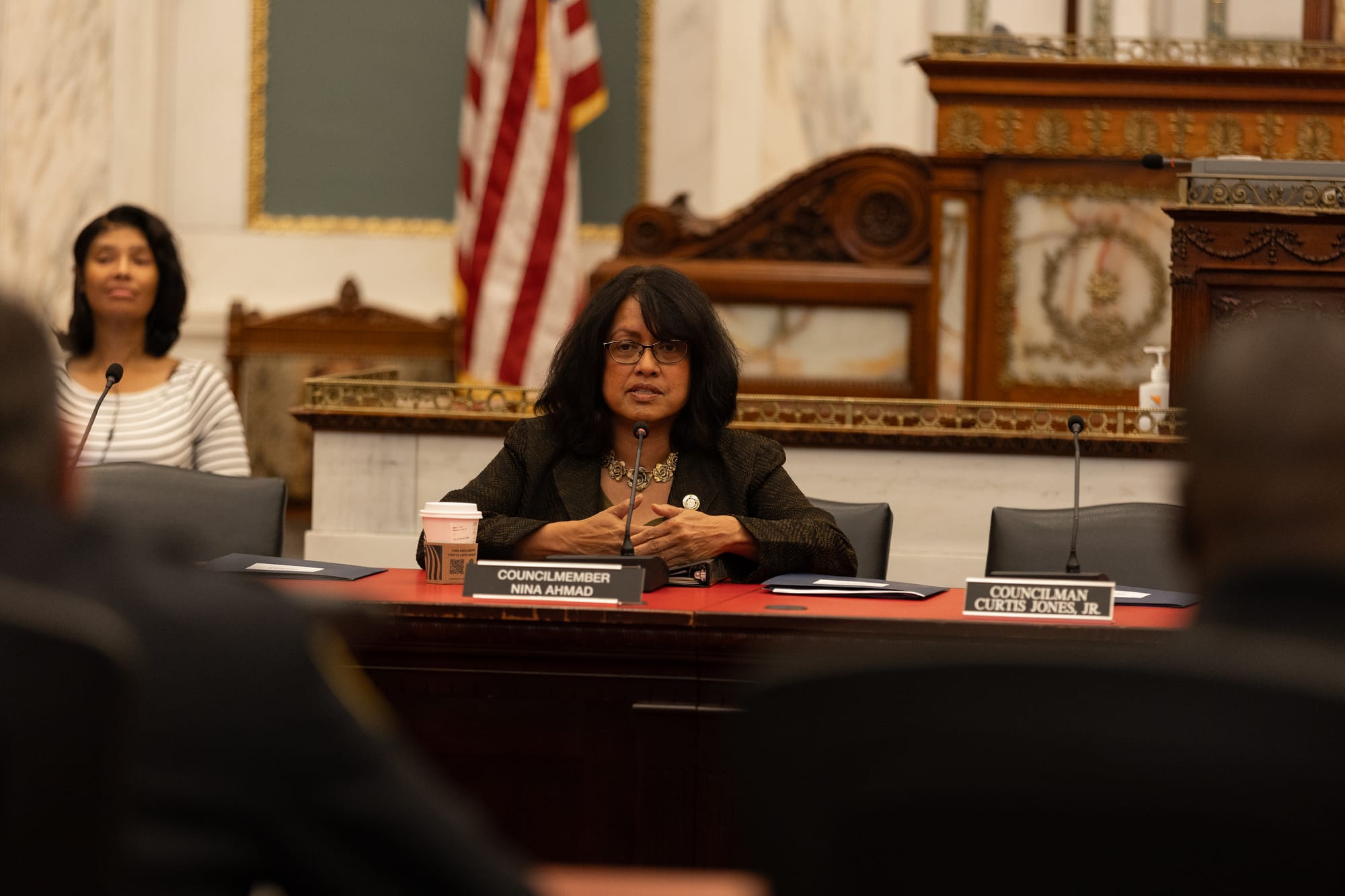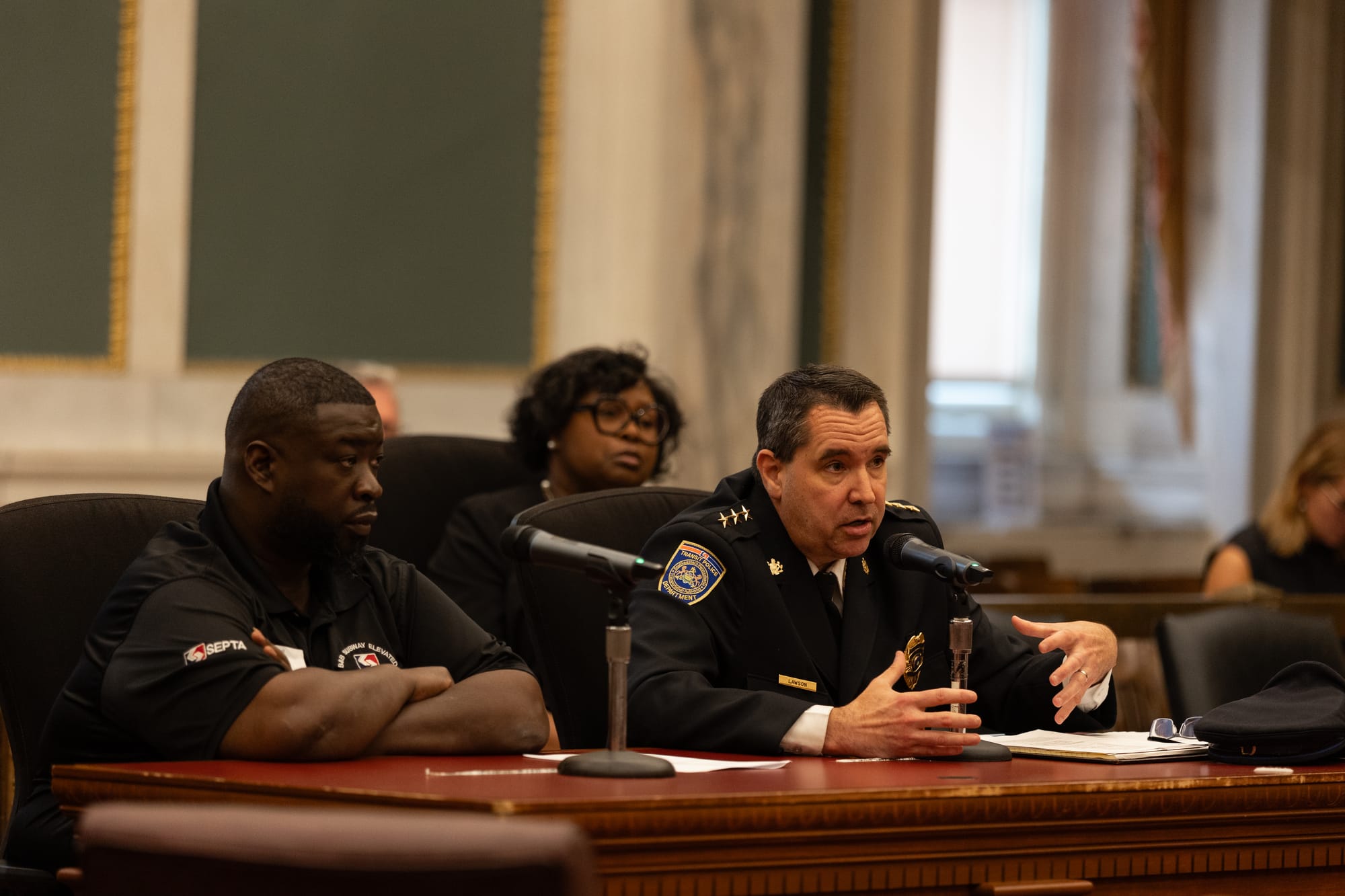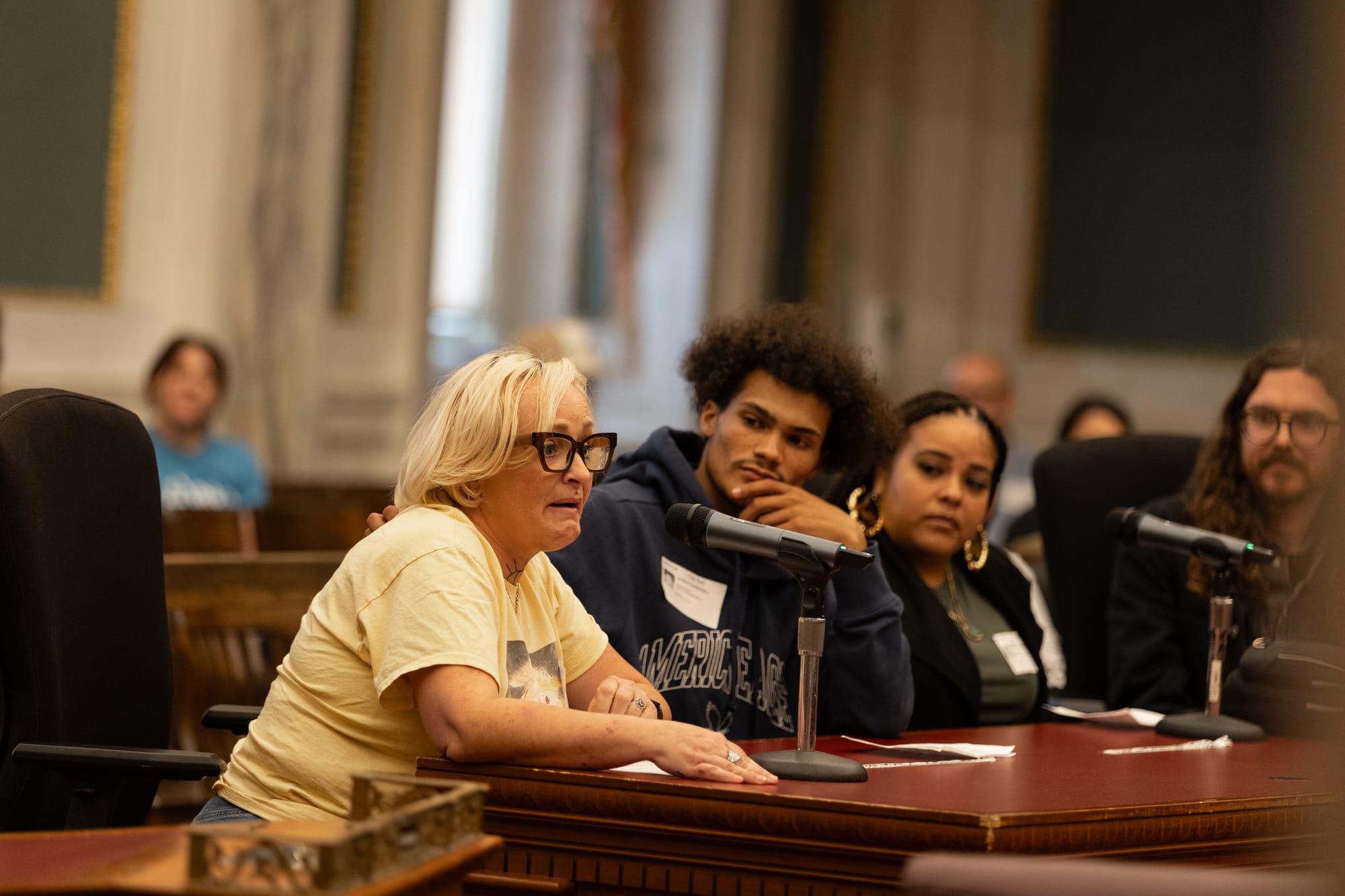Philly’s only 2025 gift guide with spiritual consults, PPA evasion and a Kensington Jason Kelce tee
This year’s holiday gift guide highlights creative, hyperlocal gifts that support Kensington’s artists, makers, and small businesses.

The Special Committee on Kensington, made up of council members Quetcy Lozada, Mark Squilla, Mike Driscoll, Nina Ahmad, Curtis Jones and Jim Harrity, held three hearings in May to examine the strategies various city departments, SEPTA, and outside organizations are using to address the opioid crisis in Kensington.
Council heard from Philadelphia’s Department of Behavioral Health and Intellectual and DisAbility Services (DBHIDS), the Center for Addiction Medicine and Policy at the University of Pennsylvania, SEPTA, and Mural Arts.
Attendees of the hearings debated how to connect people who use drugs to treatment while also addressing the community’s quality-of-life concerns. Some council members contended the city should be more aggressive in its approach and move toward involuntary treatment – a change that would require new state legislation, which has already been introduced in the Senate.
Public health researchers and service providers argued repeated, non-judgmental outreach is key.
“Expecting immediate transformation is unrealistic, but every interaction, every act of care, increases the chance that maybe something will click next time,” said Diamond Stahl, a substance use navigator who works in Kensington.
On May 16, Council member Nina Ahmad claimed the city’s behavioral health department was not coming up with “bold” and “innovative” solutions and lacked urgency.
“You have not told me anything except that you keep sending out troops to talk to people and engage them and then hope they change their mind. We cannot let that happen anymore,” Ahmad said.
Meanwhile, a panel of experts and outreach workers said people with substance use disorder are more likely to accept treatment the more contact they have with outreach teams.
Individuals who have had one contact with outreach have a 17% placement rate, whereas individuals who have had five or more contacts have a 46% placement rate, according to data collected by the department.
Diamond Stahl credits consistent outreach and peer support for saving her life after she was unhoused in Kensington. She’s been sober for three years now, and is a certified recovery specialist at the University of Pennsylvania and serves as a substance use navigator for Kensington Neighborhood Wellness Court on Wednesdays.
Stahl was one of a panel of addiction experts who advocated for continued investment in street outreach to the committee.
“I didn't get better the first time someone offered help, it took time, and it took people who never gave up on me,”Stahl said.
Public health experts argued outreach should be at the heart of Philadelphia’s strategy to address the opioid crisis moving forward.
“It saves lives,” said Dr. Jeanmarie Perrone, professor of Emergency Medicine and director of the Center for Addiction Medicine and Policy at the University of Pennsylvania. “The opioid crisis cannot be solved from the emergency department or clinics. We must go to the people who need us most.”
Amanda David, interim deputy commissioner of DBHIDS, mentioned needing more “off-ramp” placements for people in recovery, like long-term housing, and Perrone said using a “housing first model” would help people get off the street and into recovery.
David also talked about needing more low barrier placements for individuals who are not necessarily ready for treatment, but in need of shelter, where “conversations can happen to motivate people more toward treatment.”
According to Philadelphia Police Department Deputy Commissioner Pedro Rosario, there were 368 unhoused people within the 24th, 25th, and 26th police districts, which covers Kensington, as of May 16. That’s compared to 412 people at the same time last year.
“A lot of times, people just need to come in, eat something, be treated with respect, take a shower, sleep for a little bit,” David said. “Because when you're in that constant survival mode, you're not able to think about being hopeful for recovery.”
The panelists mentioned how they’re addressing withdrawal symptoms from medetomidine, a veterinary tranquilizer that has been introduced in the city’s drug supply.
“People are having severe withdrawal like nothing we've ever seen," Perrone said, "It's really a whole new category of challenges in withdrawal management. Most patients need to go to the ICU for a couple of days."
She added that people need easier and quicker access to medication for withdrawal management as they’re in the process of being connected to services, as well as access to long acting injectable medications to treat opioid addiction.
Council member Lozada pressed for strategies that would allow for outreach and services “without impacting the quality of life of the residents.” Her bill, which severely restricts where mobile services can operate in most of Kensington, was signed into law last week by Mayor Cherelle Parker.
The legislation requires mobile medical service providers to apply for permits to operate in a city-designated location or between 11 p.m. and 6 a.m. on a two-block stretch of Allegheny Avenue. Opponents have argued that not being able to meet people in need where they are will lead to them losing access to live-saving care.

Both Lozada and council member Ahmad pushed for the city to consider involuntary treatment.
State Sen. Anthony Williams introduced legislation in early May that would legalize involuntary commitment for people with substance use disorder — a move he said was requested by Philadelphia Mayor Cherelle Parker.
While David would not share an opinion on the method, she said she would be part of a conversation in the future about what the process would look like. She said if the bill were to pass, DBHIDS would work with the administration and look at how other states use it.
Lozada said there are currently 37 states that have involuntary commitment for substance use disorder.
“I know that my team will be looking at what those states are doing and I encourage all of us who are in this space to look at that,” Lozada said.
Ahmad wasn’t satisfied by any of the solutions brought by the University of Pennsylvania or DBHIDS, and wondered why no one mentioned “removing” people with substance use disorder out of the neighborhood.
“Forget the mobile providers,” Ahmad said. “The question is, we want what we have in Chestnut Hill. Would you ever see this in Chestnut Hill? Nope, in one minute, you would be driven out. Every one of you would be driven out of there.”
Ahmad criticized the panelists for not considering what the families who live in Kensington need and how they’re negatively impacted by the opioid crisis. She said people using drugs need to take responsibility for harm caused to the community.
“When you have a person hurting a child, we put them away,” Ahmad said. “These people are hurting people, including themselves, and we are not willing to address that ... I don't know why all of you evolved people have not thought about that, about, how do you make a Chestnut Hill in Kensington?
“Kensington Hill,” Lozada said.

At a May 27 hearing, a SEPTA official revealed that the agency has paused its contracts with Kensington-area social service providers who conducted outreach along the corridor, while increasing spending on fare evasion enforcement efforts.
SEPTA employs 250 transit police officers – more than it’s had in a decade — according to Charles Lawson, Chief of Police for SEPTA’s transit police department. He anticipates hiring 14 more officers in 2025.
Lawson testified in front of the Special Committee on Kensington, and shared that SEPTA has “more than doubled spending on safety, security, and cleaning priorities” over the past three fiscal years.
This comes as the agency threatens to dramatically reduce services and increase fares later this year due to a budget deficit.
Meanwhile Lawson said SEPTA “paused” its contracts with third-party contractors, including Merakey, One Day At a Time (ODAAT), and Eagle Staffing in February. The organizations were hired to connect people living with substance use disorder to various supportive services. Merakey staff also transported people to the Police Assisted Diversion (PAD) office, now the Kensington Wellness Center.
A Merakey spokesperson declined to comment “on any ongoing discussions it is having with SEPTA.”
SEPTA is preparing new contracts for July 1, according to Lawson.
Lawson said from 2023 to 2024, “serious crime” at the four SEPTA stations in Kensington decreased by more than 20%.
The agency launched an enforcement blitz at Huntingdon station earlier this spring, and began treating fare evasion as a crime in June 2024. So rather than issuing tickets, transit police can issue people who jump turnstiles a summary citation and an order to appear in court.
Video has recently circulated on social media of a SEPTA police officer tackling, pinning down, and arresting a 19-year old woman for alleged fare evasion at a South Philly station, which has led to a lawsuit against the agency. In 2022, SEPTA tased a woman after she allegedly didn’t pay a bus fare.
SEPTA budgeted $10 million for fiscal year 2026 to install more than 100 full-height fare gates, designed to prevent fare evaders, at nine more stations.
Regarding social service workers around SEPTA stations, Lawson said they were a major part of addressing substance use, but that the agency paused the contracts due to “a lack of oversight and accountability” on SEPTA’s end.
Lawson said SEPTA is working on building a “better, stronger contract” with their partners.
“We don't want this to go away ... we saw instantaneous improvement when we moved away from police officers doing this work to folks who really know what they're doing in this field,” Lawson added.
But he also shared criticism of providers — claiming that they "have historically failed to meet the head counts that we wanted” and that they "never saw the total amount of outreach teams that [SEPTA was] paying for."
Lawson said that some contractors are not comfortable with SEPTA's outreach model, which he described as incentivizing people to accept treatment, and "removing" people if they reject help.
He said “people feel comfortable using drugs on SEPTA because it's safer. They're less likely to get robbed. They're more likely to be revived by somebody with Narcan if they happen to overdose, as opposed to an alleyway.”
There are no supervised safe injection sites in Kensington, following a near city-wide ban passed by city council in 2023.
Lawson said SEPTA is comfortable using a “bigger hammer” than others, to “get rid of” people using drugs on public transit.
“Our whole model is built on discomfort,” Lawson said. “If we’re keeping people comfortable not accepting treatment then we have to find a way to push them out.”

Becky Shenk found Mural Arts’ Color Me Back program through word-of-mouth when she was unhoused in Kensington in 2021. It offers people experiencing economic instability paid opportunities to participate in public art making and on-site access to social services.
She’s now an assistant artist and teaching artist for the program.
“Mural Arts changed my life,” Shenk said in her May 27 testimony. “I wouldn't be here today to speak to you about how great a program it was for me, because I would be dead.”
Mayor Parker is proposing a cut to Mural Arts funding — $3.7 million for 2026 compared to the $5.2 million for 2025. The city funding made up about a quarter of its over $18.3 million annual budget.
Program leaders and participants testified to counsel about the impact of the program, and its potential to combat the opioid crisis and poverty. Mural Arts also requested council consider increasing funding for 2026 to support its job-readiness programs and so the organization can offer more paths to long-term employment.
Shenk said working on public art projects empowered her to change, gave her purpose, and surrounded her with people who were invested in her future. After finding Color Me Back, she eventually entered an addiction treatment program and was promised a job by Mural Arts once she finished.
“So not only did they accept me at my worst, but they hired me at my best. I've been two and a half years clean now,” Shank said.
Color Me Back mostly serves people living with substance use disorder and/or mental health concerns and offers wraparound services, including connection to peer/recovery specialists, CareerLink, and a Community Health Worker through the city’s Office of Community Empowerment and Opportunity. Thirty participants are selected every week to work at one of the program’s two sites – one in Kensington and the other at the Suburban SEPTA Station in Center City – and are paid $50 to work four consecutive 3.5 hour shifts.
Sandy Sheller, president of the Sheller Family Foundation, which funds Mural Arts, proposed paying participants stipends while they complete apprenticeships for unions, creating pipelines to permanent work.
“Art is a way of seeing... What they’re doing is showing people a different way of seeing,” Sheller said.
The organization has distributed roughly $660,000 in direct payments to about 1,400 Color Me Back participants since April 2019, according to data provided by Mural Arts. They have connected 248 people to PA CareerLink and placed 46 in jobs, while also completing six public art projects each year. There are currently 260 individuals on the waitlist.
Stay informed with community-driven reporting, local events, and neighborhood updates — every week, free to your inbox.